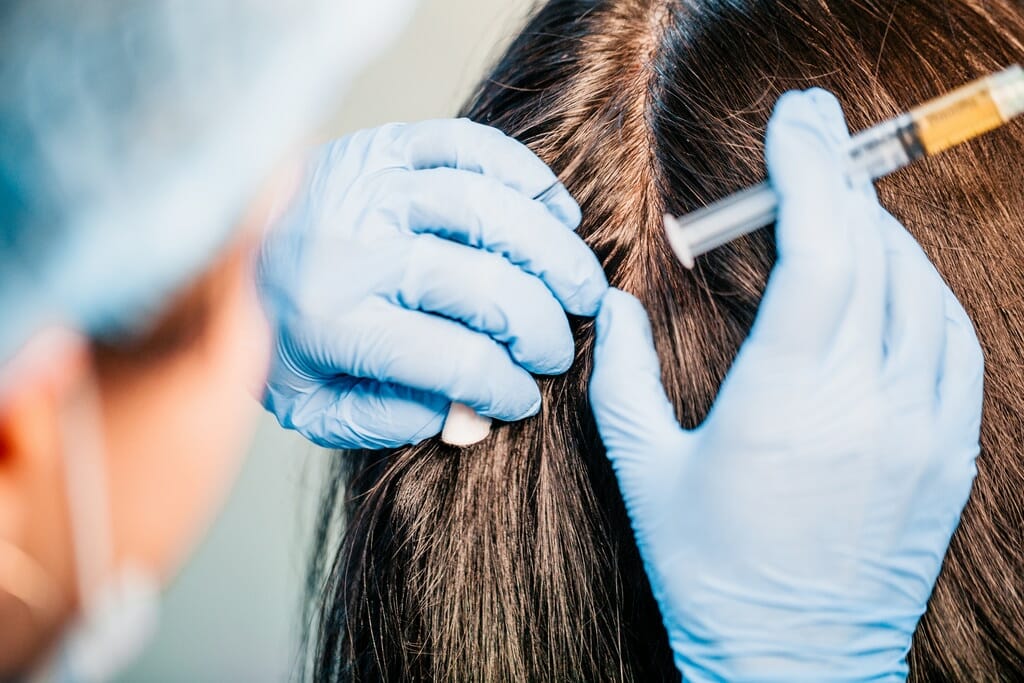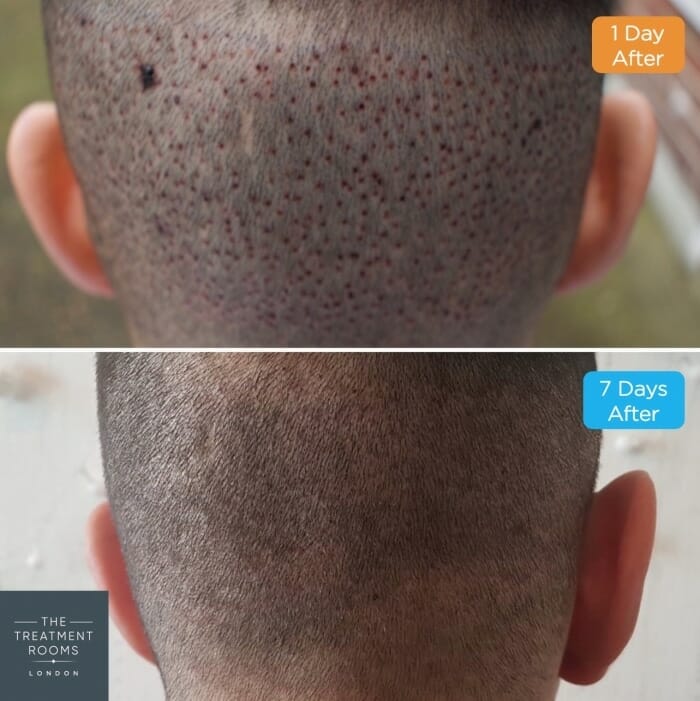Female hair loss is extremely common, particularly after pregnancy and menopause. In fact, it can affect as many as one in three women. Losing your hair can detrimentally affect your self-esteem and well-being. Fortunately, several non-invasive and effective hair loss treatments are available to reduce hair loss and even reverse it.
There are many causes of female hair loss, so establishing the correct diagnosis at an early stage is very important for treatment. As with male hair loss, androgenic alopecia is the most common cause of hair loss in women.
The Treatment Rooms offers solutions for female hair loss. Whether you require non-surgical treatments or FUE hair transplant surgery to restore your hair, our Surgeons can help you achieve your treatment goals.

What is female hair loss?
Hair loss is a fairly common condition that affects up to 56% of women over the age of 70 and fewer than 10% of women before menopause. The process may cause the hair to thin or completely diminish on certain areas of the scalp. It may also occur gradually or suddenly and be temporary or permanent, depending on the type of hair loss.
Hair loss is not generally something to worry about, but some people may find it upsetting. Nevertheless, there are treatments are available to improve hair loss and they differ depending on its cause.
Causes of hair loss in women
Daily hair loss is normal. Most people tend to lose around 50–100 hair strands each day. Since there are around 100,000 follicles on the scalp, losing up to 100 hairs does not make a significant difference to someone’s appearance. It usually goes unnoticed, especially as the new hair grows simultaneously. However, hair loss occurs when there is no longer new hair growing through to replace the hair that falls out.
Causes of hair loss in women may include:
- Family history: Hereditary hair loss means that someone has inherited genes that cause hair follicles to shrink as they age, eventually resulting in the follicle no longer growing hair
- Age: Most people notice hair loss as they get older because hair growth slows down and some follicles may stop growing hair, causing scalp hair to thin
- Hormonal imbalance: Polycystic ovary syndrome (PCOS) is a condition that affects women and often causes hair loss
- Stress: When the body is under stress, such as illness, having an operation or during a time when someone suffers the death of a loved one, people may experience temporary hair loss due to stress
- Hair care: Over time, colouring, perming, or relaxing hair may cause damage and lead to hair loss
- Hairstyles: Regularly wearing hair pulled back tightly may lead to a hair loss condition known as traction alopecia
- Medical conditions: Some medical conditions may result in hair loss, such as alopecia areata, scarring alopecia, an underactive or overactive thyroid, and a recurrent hair-pulling disorder called trichotillomania
- Scalp conditions: Scalp psoriasis and scalp infections, such as ringworm, can lead to hair loss
- Medications: Some medications may have a potential side effect of hair loss
- Cancer treatments: Chemotherapy and radiotherapy may cause hair loss within a few weeks of starting treatment
- Sexually transmitted infections (STIs): Without treatment, STIs such as syphilis may result in patchy hair loss on the scalp and eyebrows
- Nutrient deficiencies: Having too little iron, folate, zinc, or biotin in the diet may cause noticeable hair loss
Most people experience thinning hair with age. However, if they are losing considerably more hair each day than usual, they may have an underlying condition causing hair loss which needs evaluation from a hair loss specialist. Medications for hair loss may be recommended or in some circumstances, hair transplant surgery may be be indicated.
Take a look at our FUE hair transplant page to better understand how female hair transplants work.
Signs of hair loss in women
Hair loss patterns tend to differ between men and women. For example, male pattern baldness is normally localised to specific areas, such as the temples and the crown. But females typically have widespread thinning on the crown area or a widening of their parting.
Clinicians often use the Ludwig scale to assess the degree of female pattern hair loss. The Ludwig scale presents 3 stages of hair loss in women ranging from no hair loss to severe hair loss.

Types of female hair loss
Women may experience several types of hair loss, but female pattern hair loss, also known as androgenetic alopecia, is the most common. Female pattern hair loss has characteristics such as thinning hair on the central area of the scalp.
Types of female hair loss include:
- Female pattern hair loss
- Alopecia areata
- Telogen effluvium
- Traction alopecia
Female pattern hair loss
Female pattern hair loss can begin any time after puberty and usually before the age of 40. This type of hair loss runs in families, so a person will inherit the genes that play a role in female pattern hair loss from either their mother, father, or both.
A combination of genetic and hormonal factors are thought to cause female pattern hair loss. Testosterone converts to dihydrotestosterone (DHT) in skin cells. Both testosterone and DHT belong to a group of hormones called androgens that contribute to growth and reproduction in both men and women.
Researchers suggest that with male pattern baldness, the androgen-related activity causes hair follicles to shrink to a point where hair no longer grows and eventually falls out. This same process is thought to also contribute to hair loss in females too.
Studies indicate that female pattern hair loss may relate to many factors, including:
- Genetic influences
- Androgen levels and sensitivity
- Potential inflammation in the scalp
Female pattern hair loss is also present in around 20–30% of individuals with PCOS. This is because in PCOS, the level of Testosterone is on average slightly higher than a female without the condition. As a result in those suffering from PCOS, underlying process of hair loss is more noticeable.
Alopecia areata
Alopecia areata is an autoimmune disorder. Autoimmune disorders occur when the immune system mistakenly attacks part of the body. With alopecia areata, the immune system attacks hair follicles.
Alopecia areata affects an estimated 15 in 10,000 people in the U.K. It can occur at any age, but around 50% of alopecia areata cases start to happen in childhood, and 80% occur by the age of 40.
The typical pattern of hair loss for alopecia areata is the appearance of one or more bald patches on the scalp. The patches are usually round and the size of a large coin, and may develop on any area of the scalp.
People may not notice they have alopecia areata, particularly if they have long hair covering the bald areas. Unfortunately, there is no cure for alopecia areata, but hair may start to grow back at any time without treatment.
Telogen effluvium
Telogen effluvium is a form of temporary excessive hair loss. Most people shed up to 100 hairs per day, but someone with telogen effluvium may lose an average of 300 hairs or, rarely, more than 1,000 hairs.
Normally, hair follows a cycle of growth for 2–6 years, entering a resting state for a few months, and then falls out. However, telogen effluvium causes many hair follicles in the growing phase of the cycle to abruptly switch to the resting phase, resulting in hair shedding and loss of hair volume.
There is at times no obvious cause of the condition. However, common triggers may include:
- Changes in diet
- Weight loss
- Iron deficiency
- Stress
- Fever
- Infection
- Hormonal changes due to childbirth or menopause
- Hypothyroidism or hyperthyroidism
- Certain medications
- Injury
- Surgery
After resolving the cause of telogen effluvium, hair usually returns to a normal thickness within a few months.
Traction alopecia
Traction alopecia is hair loss occurring from repeatedly pulling hair. The strain on the hair follicles from tugging on hair results in damage to the follicles which prevents them from producing new hair.
Traction alopecia often results from:
- Tight braids and dreadlocks
- Tight buns and ponytails
- Wearing wigs
- Attaching weaves or hair extensions
- Using curling rollers
- Weaving
People with traction alopecia may notice broken hairs, and areas of sparse hair covering in areas where the hair is pulled at its highest tension. It typically affects the hairs at the front and sides of the scalp, depending on the hairstyle causing the condition.
Traction alopecia can be reversible. However, if people continue to style their hair the same way, it may become permanent.
Female hair loss treatment
In most cases hair loss does not require treatment. However, if you are experiencing severe hair loss we recommend speaking to your doctor or a professional hair loss surgeon to explore your condition and discuss the best possible treatment options.
At The Treatment Rooms London, we offer non-surgical and surgical treatments to improve female hair loss.
Our focus is on creating treatment plans which take into account your long-term goals for your hair. This is most important when considering permanent female hair loss. Our doctors work closely with you to advise on treatments that will help reduce the effects of thinning. We often advise you to reach out to your GP to explore causes and treatments such as Minoxidil for your hair loss before considering surgery.
Non-surgical hair loss treatment for women
We often advise on non-surgical hair loss options as a first-line treatment for female pattern hair loss at The Treatment Rooms. The main non-surgical treatment includes:
Minoxidil (Regaine)
Minoxidil is a hair loss treatment for women available as a solution and foam. Women can use the solution on their hair and scalp twice a day or the foam once a day.
Products containing Minoxidil may slow hair loss and promote regrowth by:
- Reversing follicle shrinkage
- Stimulating hair follicles from a resting to a growth state
- Extending the hair follicle’s growth phase
Women should not use Minoxidil during pregnancy and should consult their doctor before using it while breastfeeding.
Hair transplants for women
Hair transplants are also a solution to women suffering from hair loss. Before exploring whether surgery is of benefit for a female, it is important to rule out any underlying medical condition that is driving the hair loss. For this reason, we often advise female patients touch base with their GP before making plans for surgery.
Hair restoration surgery can be used to improve areas of thinning or balding. Using the latest FUE surgical techniques we can replenish hairlines, hair partitions, or focal areas where the thinning is most established. The procedure is associated with minimal downtime and with our minimal-shave technique we provide you with additional discretion.
Surgeons perform hair transplants using a local anaesthetic, which means that after the initial numbing injections a patient should not feel any more pain.
There are currently two types of hair transplants available for women: follicular unit transplantation (FUT) and follicular unit excision (FUE). The FUT technique can be useful for those women who want to have large procedures or want to have a minimal shave to the back of the head. The FUE hair transplant procedure is often chosen for women who have small- medium requirements and don't mind having a minimal shave at the back of the head that is concealed with longer hair. At The Treatment Rooms London, we solely provide FUE hair transplant surgery to our patients.
Follicular Unit Transplantation (FUT)
A FUT transplant (linear strip excision) involves the following:
- A surgeon removes a thin strip of scalp containing hair from the back of the head
- They divide the strip into pieces, known as grafts, containing 1–4 hairs
- A surgeon makes small incisions in the scalp and places the grafts
- They stitch the area where they removed the hairs leaving a long line scar at the back that is concealed when the hair is long
Surgeons will need to shave their head at the back where the strip of scalp is taken out and in the area where hairs are being implanted. This method is more invasive than FUE hair transplant surgery, which means the recovery time associated with FUT transplant surgery is a longer and can be more difficult to manage.
Follicular Unit Excision (FUE)
An FUE hair transplant involves the following:
- A surgeon extracts individual healthy follicles from the back and sides of the scalp.
- They reinsert the extracted hair follicles using sub-millimetre techniques that puncture the scalp to transplant the hair follicle
- A surgeon uses specialist techniques to achieve realistic hair depth, angulation, direction, and density
After an FUE transplant, there will be dot-like scars in the area where the surgeon extracted the hair follicles. The hair transplant scars are not usually visible once the surrounding hairs start growing and reach a length 1 or 2.
FUE hair transplants are considered a more modern technique when compared to an FUT with a quicker healing process and downtime. The result from an FUE hair transplant should from 15 years to a lifetime.
To find out more about FUE hair transplants, please visit our page.
How our surgeons can help with female hair loss
At The Treatment Rooms, our focus is on creating effective treatment plans that help you achieve your long-term hair goals. Our hair loss surgeons work closely with you to determine the best course of treatment following hair loss.
Booking a consultation with one of our surgeons enables us to evaluate your hair and tailor our treatments to meet your needs. We also provide a meticulous aftercare and recovery plan that gives you every opportunity of having a result you are pleased with.
FUE Hair Transplant Frequently Asked Questions
Authored by
Reviewed by
FUE HAIR TRANSPLANT REVIEWS
Latest News
Castor Oil (Ricino Oil) for Hair Growth: Benefits, Uses & How to Apply for Maximum Results
June 26, 2025
Castor oil, also known as Ricino oil, is extracted from the Castor bean plant (Ricinus communis). During…
What is a Hair Transplant? How it Works, Success Rate & What to Expect
June 23, 2025
Hair transplantation is a cosmetic surgical procedure that restores hair by moving healthy follicles from one part…
John Cena Hair Transplant
May 14, 2025
John Cena, a common household name, is a figure who has effortlessly straddled the worlds of professional…








